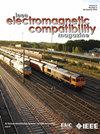Lightning Attachment Behavior of Metamaterial Plate From Lightning and Switching Impulse Discharge Tests
IF 2.5
3区 计算机科学
Q3 ENGINEERING, ELECTRICAL & ELECTRONIC
IEEE Transactions on Electromagnetic Compatibility
Pub Date : 2025-04-09
DOI:10.1109/TEMC.2025.3555121
引用次数: 0
Abstract
Electromagnetic metamaterials have excellent electromagnetic properties, and can be widely used in radome, which, however, might suffer from damage by lightning in thunderstorm days. Here, using lightning and switching impulse discharge tests, we investigate the lightning attachment behavior of the equivalent plate for radome. We examine the influence of the metamaterial type, the spacing of diverter strips, polarity and waveform of the impulse on the lightning attachment behavior by observing the streamer development and statistics of the lightning attachment counts. As expected, the lightning protection effectiveness of diverter strips for metamaterial plates is worse than that for conventional dielectric plates, and the protection effectiveness decreases as the spacing of diverter strips increases. Unexpectedly, the lightning attachment behavior do not differ too much between metamaterial plates with diverse metal microstructure units. Moreover, the polarity of the impulse and the voltage waveform are found to have a remarkable influence, suggesting that the impulses with a positive polarity or longer durations are more likely to attach to the metamaterial plates. The results offer theoretical insights into optimizing the lightning protection for metamaterial radomes.从雷电和开关脉冲放电试验看超材料板的雷电附着特性
电磁超材料具有优异的电磁性能,可广泛应用于雷达罩,但在雷雨天气可能受到雷电的破坏。本文采用雷电试验和开关脉冲放电试验,研究了天线罩等效板的雷电附着特性。通过观察流线的发展和闪电附着次数的统计,研究了超材料类型、导流带间距、脉冲极性和波形对闪电附着行为的影响。结果表明,超材料板的导流条的防雷效果不如常规介质板,且随着导流条间距的增大,其防雷效果逐渐降低。出乎意料的是,具有不同金属微观结构单元的超材料板的闪电附着行为没有太大差异。此外,发现脉冲的极性和电压波形有显著的影响,这表明具有正极性或持续时间较长的脉冲更有可能附着在超材料板上。该结果为优化超材料天线罩的防雷提供了理论见解。
本文章由计算机程序翻译,如有差异,请以英文原文为准。
求助全文
约1分钟内获得全文
求助全文
来源期刊
CiteScore
4.80
自引率
19.00%
发文量
235
审稿时长
2.3 months
期刊介绍:
IEEE Transactions on Electromagnetic Compatibility publishes original and significant contributions related to all disciplines of electromagnetic compatibility (EMC) and relevant methods to predict, assess and prevent electromagnetic interference (EMI) and increase device/product immunity. The scope of the publication includes, but is not limited to Electromagnetic Environments; Interference Control; EMC and EMI Modeling; High Power Electromagnetics; EMC Standards, Methods of EMC Measurements; Computational Electromagnetics and Signal and Power Integrity, as applied or directly related to Electromagnetic Compatibility problems; Transmission Lines; Electrostatic Discharge and Lightning Effects; EMC in Wireless and Optical Technologies; EMC in Printed Circuit Board and System Design.

 求助内容:
求助内容: 应助结果提醒方式:
应助结果提醒方式:


